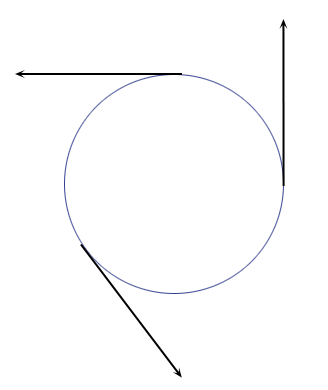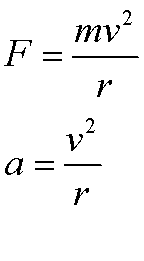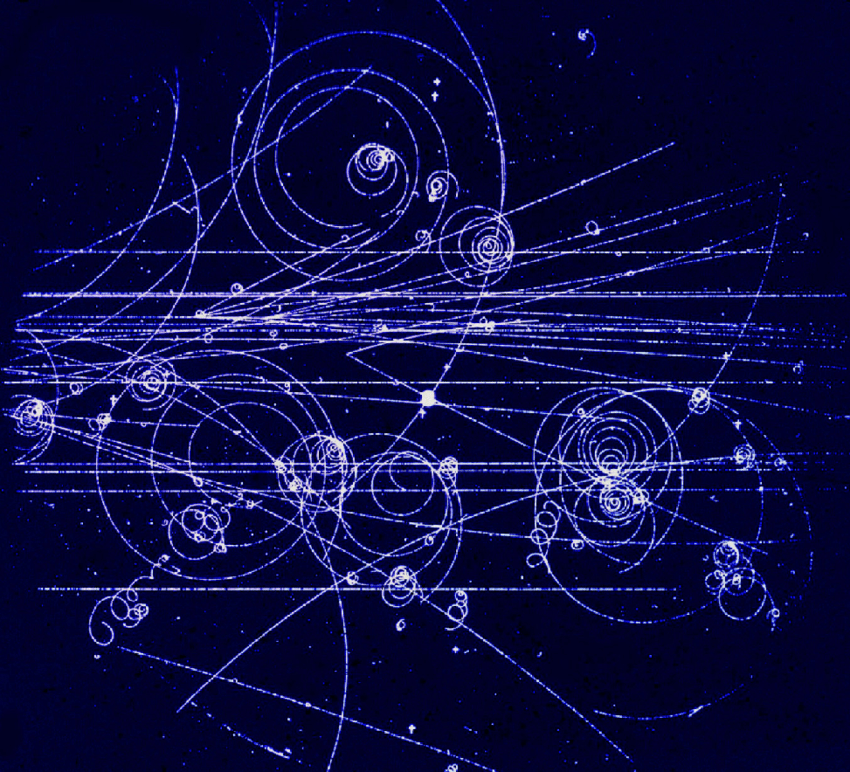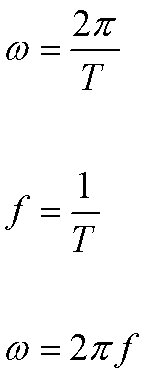Physics > Motion > Uniform circular motion
Uniform circular circular motion is about an object that moves in a circle, at constant speed.
Although the speed is constant, the velocity is not (remember that velocity is a vector so that it implies a speed and a direction), because the direction of movement changes constantly and that is the tangent to the circle. To change velocity a force is needed, and in this case it is called the centripetal force.

Velocity vectors for an object in uniform circular motion. The module of the vector is constant. Only its direction changes.
The centripetal force is not a new force to complicate things further! It is just the name given to the force that is changing the direction of movement, pulling the object towards the centre of a circle. I will now give examples of different types of centripetal forces to make things more clear.
In most exercises and problems (check here the problems and exercises) the centripetal force is one of these forces: gravity, friction, magnetic, electric, normal (or reaction) or the tension in a string.
A typical exercise on centripetal forces and gravity involves circular orbits of planets and satellites. Friction is related to cars making curves on roads, for instance, and tension will be calculated for objects doing circular trajectories attached to strings. The electric force is the centripetal force in an atom, responsible for the attraction between electrons and nucleus.
Formulas:
The formulas for centripetal force and acceleration are given below :

The formula for centripetal acceleration is obtained dividing the force by the mass according to Newton´s second law (F=ma).
Examples of calculations:
1) If a car of mass 1000kg is doing a curve of radius 10m at 25 m/s, what is the force needed to keep him on track?
F = 1000 * 252 / 10 = 62500 N . The centripetal force in this case is the friction between car tyres and road.
2) A weight of mass 1 kg is attached to the end of a string 3 m long and doing uniform circular motion in a horizontal plane. If the maximum tension the string can take is 100 N, what is the maximum velocity possible?
In this case the centripetal force is the tension in the string. So,
100 = 1*v2 / 3 => v2 = 300 => v = 17.3 m/s
The case of the vertical circle is treated on the exercises pages.
3) A charged particle moves perpendicular to magnetic field . Find the radius of the trajectory.
In this case the centripetal force is the magnetic force. So, we will need the formula for the force on the charged particle when it crosses the magnetic field perpendicularly (if it was parallel to the field there would be no force):
F = QvB, where Q is the electric charge of the particle, v is its velocity and B is the intensity of the magnetic field.
QvB = mv2 / r
r = mv/QB
Notice that the larger the mass, the larger the radius. The larger the charge, the smaller the radius. This results allow us to make sense of what is observed in particle physics experiments, like those tracks made by particles on the image below:

Trajectories of subatomic particles in a Cloud Chamber (Image from Gordon Fraser/CERN, http://cerncourier.com/cws/article/cern/28742) - Creative Commons Attribution 4.0 International
On the image above the different particles produced in the experiment can be characterized based on the radius of the tracks and also the directions of deflections, according to the sign of the charge (+ or -). Look the various different radii that are recorded.
This chapter also involves some concepts( and formulas) that are also used in the chapters waves and harmonic motion . Those are : angular velocity (ω), period (T) and frequency (f).
Angular velocity:
So far, we used the linear velocity (v) in the calculations. Now we introduce the concept of angular velocity.
In dealing with circular motion is often more convenient to use angular rather than linear quantities.
The angular velocity (ω) corresponds to the angle swept, per interval of time, rather than the distance travelled. It is usually given in radians / s. Review radians.
An angle of 360 degrees corresponds to 2π in radians, so that 180 degrees is π radians, 90 degrees is π/2 radians and so on.
The period (T) is the time taken for one complete circle . The frequency f is the number of circles completed in one second; it is measured in Hz (hertz).
So the angular velocity is the angle swept divided by the time taken. In the case of a complete circle we have:

The linear velocity is the angular velocity multiplied by the radius:
![]()
Example
The angular velocity of the Earth is constant but the linear velocity at the equator is huger than close to the poles. In fact, the linear velocity at the pole is zero.
Example calculation:
A turntable spins at 33 rpm. What’s is the angular velocity? What is the linear velocity 10 cm from the centre?
Answer:
33 rotations in 60 s corresponds to a frequency of 0.55 Hz
The angular speed is ω = 2π f = 2π*0.55 = 3.4 radians /s
The linear velocity is ωr =3.4*0.10 = 0.34 m/s
